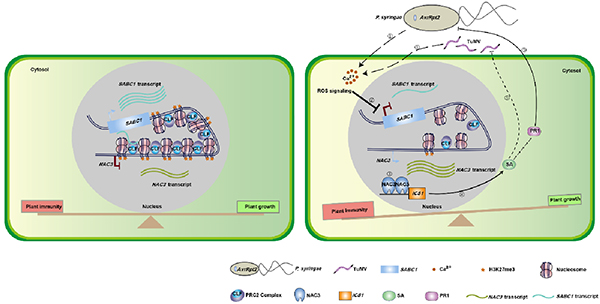In response to different biotic stresses, terrestrial plants have evolved complex and powerful immune systems. However, the persistent activation of the immune system would seriously damage plant development and growth. To balance immune responses and fitness costs, plant immunity is tightly controlled under normal conditions and quickly activated upon pathogen infection. The underlying molecular mechanisms in balancing plant immunity and growth are still poorly understood. Long non-coding RNAs (lncRNAs) are a class of RNAs (> 200 nt) that lack functional open reading frames (ORFs). Although the biological functions of a few lncRNAs in plant development have been revealed, how these lncRNAs with low expression effectively modulate diverse biological processes, including plant immune responses, remain largely unknown.
Now, researchers led by Prof. Zhang Xiaoming and Prof. Chen Jinfeng at the Institute of Zoology of the Chinese Academy of Sciences (CAS), and Prof. Qian Weiqiang at Peking University have unraveled a lncRNA-based regulatory mechanism to modulate the balance between plant immunity and growth. The study was published in Cell Host & Microbe.

The balance of immunity and growth would finally decide the crop yield. Liu et al., report the fine-turning mechanism of lncRNA on plant immunity and growth balance. The Yin-Yang fish has been widely used to represent the balance of two different properties or the transformation between them. The black fish represents the growth of plants and the red fish represents the immunity responses of plants.
The researchers identified a lncRNA termed salicylic acid biogenesis controller 1 (SABC1), that decreases upon infection of bacteria pathogen, Pseudomonas syringae strain DC3000-avrRpt2. They further clarified the regulatory role of SABC1 as a lncRNA in suppressing plant immunity and promoting plant growth through inhibiting its neighboring gene NAC3.NAC3 act as a transcription factor to activate transcription of isochorismate synthase 1 (ICS1), a key enzyme catalyzing salicylic acid (SA) biosynthesis. SABC1 inhibits the transcription of NAC3 by recruiting the polycomb repressive complex 2 to mediate the H3K27me3 of NAC3, which would finally repress SA production, so as to restrict immunity response and make way for plant growth. Upon bacteria and virus infection, SABC1 is downregulated to activate NAC3 transcription to trigger SA production and derepress the resistance to bacteria and viruses.
These findings reveal a lncRNA SABC1 as a molecular switch to balance plant defense and growth by modulating SA biosynthesis. Discovery on the function of long non-coding RNAs in bridging the process of early development and later resistance responses will improve the understanding of plant immune regulation, opening new perspectives for developing new crop resistance loci and mitigating the damage of pathogenic bacteria to crops.

A LncRNA fine-tunes salicylic acid biosynthesis to balance plant immunity and growth
Contact:
Xiaoming Zhang
Institute of Zoology Chinese Academy of Sciences
Tel: 86- 64806891
E-mail: zhangxm@ioz.ac.cn
Web: http://english.ioz.cas.cn/


